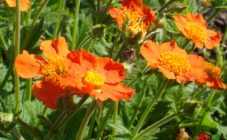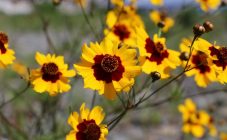Content:
Iberis is a beautifully flowering herb belonging to the Cruciferous or Cabbage family. There are several alternative names for the culture - peppers, daisies and stenniks. In the wild, Iberis is found quite often, especially in the mountains of Asia Minor and southern Europe, in the Crimea, southern Ukraine and the Caucasus.
Today there are about 40 plant species, while they can be annuals and perennials, cold-resistant and thermophilic. They also share semi-shrub and herbaceous varieties. Iberis is in great demand among gardeners due to its decorative properties, with their help flower beds, lawns and masonry are decorated.
Description and characteristics of the plant
Iberis, depending on the variety, can be perennial or annual, but all plants have a tap root system. Lying or erect stems are abundantly leafy, forming a dense growth of an approximate height of 25-30 cm. Bare leaves of light or dark color on the stem are alternately arranged. The length of each leaf plate varies from 5 to 7 cm. The leaves are characterized by a narrow, elongated or pinnately dissected shape.
Already in spring or in June-July (depending on the region of growth and weather conditions), dense umbellate flowers form and bloom on the tops of the shoots. Flowers form inflorescences up to 5 cm in diameter. Flowers can be pink, lilac, white or yellow. The core is convex, painted in a rich bright yellow color.
Varieties and decorative varieties
In the wild, there are several dozen varieties of the official Iberis, but besides this, breeders have bred decorative varieties that are in great demand among domestic agronomists.
- Iberis is evergreen perennial.
Shrubs that are common in southern Europe and Asia Minor. Height varies from 30 to 40 cm. Evergreen leaves of rich green color are formed along the stem. The plant begins to bloom in June, the diameter of each flower is 1.5 cm.
- Iberis Gorky.
Ground cover variety, the height can reach 12 cm, during flowering, snow-white flowers are formed.
- Iberis Empress.
A common ornamental variety characterized by the formation of dense dark green curtains.
Height varies from 20 to 25 cm, during flowering snow-white inflorescences are formed.
- Iberis is umbrella.
An annual plant actively grown in the garden.
In Iberis annual, branched stems are formed, the height, as a rule, does not exceed 40 cm. The stems are abundantly covered with miniature green leaves. Most varieties bloom in the second - third decade of June, snow-white inflorescences are formed. Duration of flowering "umbrella" - 2 months.
- Iberis Garnet.
A semi-shrub, capable of reaching a height of 30 cm, carmine-red inflorescences are formed during flowering.
- Iberis Blackberry.
A frost-resistant plant, during the flowering of which a large number of miniature bright pink flowers are formed.
- Iberis of Gibraltar (Gibraltar).
It is a biennial flowering low-growing plant. Branched shoots with a large amount of aerial vegetation are characteristic of it. The top of each shoot during the flowering of Iberis is decorated with white or pink umbrella inflorescences.
Iberis: planting and care in the open field
Planting and caring for Iberis is quite simple, even a novice agronomist can do it.
Growing an Iberis flower from seeds
The seed propagation method of a flowering plant is considered the simplest, which is why it is so popular. Seeding material can be purchased at any specialty store, or you can collect seeds yourself, if the plant was previously grown in a summer cottage.
It is necessary to sow seeds in open soil to a depth of no more than 5-10 mm. The optimal time for sowing is the first or second decade of April, it all depends on the climatic and weather conditions of growth.
The first shoots, as a rule, are observed after a week or two. Crops must be thinned out; a distance of 15 cm must be observed between seedlings.
If the gardener preliminarily wants to grow seedlings, then it is advisable to sow soon after the onset of spring, in early March. To do this, you will need to prepare a container with sand and well-moistened fertile soil. Seeds must be sown to a depth of 1 mm, sprinkled on top with a thin layer of sand. It is recommended to cover the container with polyethylene fiber or glass, store it in a bright and warm room.
Planting in open soil
It is recommended to transplant seedlings into open ground at the end of May, when the probability of night frosts is minimized. Iberises are light-loving plants, so the site should be sunny. Soil suitable for Iberis is loamy, sandy or rocky. Otherwise, moisture can stagnate in the ground, which will lead to the development of fungal diseases or rotting of the roots.
In young plants, the root system is very sensitive and fragile, therefore, it is necessary to transplant seedlings into open soil together with an earthen clod.
A seedling is placed in the planting hole, covered with fertile soil and tamped a little, the first watering is carried out.
Iberis care
Iberis is not a moisture-loving plant, it is necessary to water it only during flowering or in dry weather.
It is also not necessary to apply organic and mineral fertilizers to the soil. If desired, mineral fertilizers can be applied no more than 2 times during the growing season. Of course, this procedure will have a beneficial effect on the splendor, abundance and duration of flowering of the plant.
Perennials should be transplanted no more than once every 5-6 years. If not transplanted at all, the plant will bloom poorly and look unattractive.
Iberis is an amazing plant that creates a fabulous atmosphere with its bright flowering. Plants are not picky in care, therefore it is very easy to grow a strong, healthy and abundantly flowering plant in your summer cottage.















